
A | B | C | D | E | F | G | H | CH | I | J | K | L | M | N | O | P | Q | R | S | T | U | V | W | X | Y | Z | 0 | 1 | 2 | 3 | 4 | 5 | 6 | 7 | 8 | 9
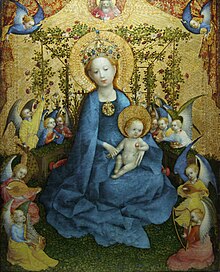
| Part of a series on the |
| Mariology of the Catholic Church |
|---|
 |
|
|
| Part of a series on the |
| Catholic Church |
|---|
 |
| Overview |
|
|
Catholic Mariology is Mariology (the systematic study of the person of Mary, mother of Jesus, and of her place in the Economy of Salvation[1][2][3]) in Catholic theology. According to the Immaculate Conception taught by the Catholic Church, she was conceived and born without sin, hence Mary is seen as having a singular dignity above the saints, receiving a higher level of veneration than all angelic spirits and blessed souls in heaven. Catholic Mariology thus studies not only her life but also the veneration of her in daily life, prayer, hymns, art, music, and architecture in modern and ancient Christianity throughout the ages.[4][5][6][7]
The four Marian dogmas of Mother of God, Immaculate Conception, perpetual virginity, and Assumption form the basis of Mariology. However, a number of other Catholic doctrines about the Virgin Mary have been developed by reference to sacred scripture, theological reasoning and church tradition. The development of Mariology is ongoing and since the beginnings it has continued to be shaped by theological analyses, writings of saints, and papal statements, e.g. while two of the dogmas are ancient, the other two were defined in the 19th and 20th centuries; and papal teachings on Mary have continued to appear in recent times.[8][9][10]
In parallel to the traditional views, since the late 19th century, as Marian devotion became more pronounced in the Catholic Church, a number of other perspectives have been presented as a challenge to Catholic Mariology. Other Christian views see Catholic Mariology as unbiblical and a denial of the uniqueness of Christ as redeemer and mediator,[11] and modern psychological interpretations see Mary as similar to mythical goddesses ranging from Diana to Guan Yin.[12][13][14] Nonetheless, most Christians including the Latin Church led by the pope, the Eastern Orthodox Church, the Oriental Orthodox Church, and the Church of the East revere Mary as the greatest saint and disregard Protestant objections to Marian devotion.
Study of Mary and her place in the Catholic Church
Context and components
The study of Mary and her place in the Catholic Church has been undertaken from a number of perspectives and within a number of contexts, and in his address to the 2012 Mariological congress, Pope Benedict XVI stated that this study must be "understood and deeply examined from different and complementary viewpoints".[15] Benedict also emphasized that the study of Mary cannot be performed in isolation from other disciplines and that Mariology is inherently related to the study of Christ and of the church, and expresses the inner coherence of these disciplines.[16]
Pope Benedict XVI has stated that Marian studies have three separate characteristics: first personalizing the church so it is not seen just as a structure but as a person, secondly the incarnational aspect and the relation to God, and third Marian piety which involves the heart and the emotional component.[17]
Mary's position in the church can be compared to the aspect of the Petrine office in a dual sense.[18] This perspective on the duality of the roles of Mary and Peter highlights the subjective holiness of the heart and the holiness of the structure of the church. In this duality, the Petrine office logically examines the charisms for their theological soundness, while the Marian dual provides a balance in the spiritual and emotional sense via the service of love that the office can never encompass. Mariology and the doctrine of office are thus not "side chapels" in Catholic teachings, but are central and integrating elements of it.[19] As referenced in the encyclical on the Mystical Body of Christ, Pius XII, 1943, her fiat gave consent for a spiritual marriage between the Son of God and human nature, thus giving humanity the means to salvation. Mary's rights (wedding feast at Cana), and Mary's love (fiat) are essential to salvation.
Maximalism and minimalism
Mariology is a field in which deeply felt pious beliefs of the faithful and hagiography may conflict with theological and critical historical reviews of beliefs and practices.[20] This conflict was recognized as early as the year 1300 by William of Ware who described the tendency of some believers to attribute almost everything to Mary.[21] Bonaventura warned against Marian maximalism: "One has to be careful as to not to minimize the honour of our Lord, Jesus Christ."[22] Both minimalist and maximalist have always seen in Mary a sign of the Catholic Church and viewed her as a model for all Catholics.[23]
In the 20th century, Pope Pius XII, "the most Marian pope in Church history",[24] warned against both exuberant exaggerations and timid minimalism in the presentation of Mary.[25][26] The Vatican II dogmatic constitution Lumen gentium was specifically written in 1964 to avoid both Marian maximalism and minimalism.[27][28] Pope John Paul II was also careful to avoid both maximalism and minimalism in his Mariology and avoided taking personal positions on issues which were subject to theological debate.[29]
Mariology and Christology
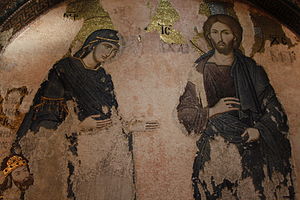
Mariology (the study of Mary) has been related to Christology (the study of Christ) and in the Catholic theological and papal writings has been viewed as interwoven with the mystery of Christ.[30] Pope John Paul II discussed the "precise place of Mary" in the plan of salvation in the encyclical Redemptoris Mater and stated: "Following the line of the Second Vatican Council, I wish to emphasize the special presence of the Mother of God in the mystery of Christ and his Church. For this is a fundamental dimension emerging from the Mariology of the Council".[31]
Catholic theologians have also explored the necessary connection of Mariology with Christology.[30] Pope Benedict XVI characterized the relationship by stating that "Christology and Mariology are inseparably interwoven" from their very beginnings.[32] In his view, Mariology underscores the nexus of the mysteries of Christology and ecclesiology, and reflects they are intrinsically interwoven.[33]
Early Christians and numerous saints focused on this connection[34] and popes highlighted the inner link between Marian doctrines and a fuller understanding of Christological themes.[35] Given the Catholic perspective that the Church lives in its relation to Christ, being the Body of Christ, it also has a relation to his mother, whose study is the subject of Catholic Mariology.[36] Pope Pius X in Ad diem illum stated: "there is no more direct road than by Mary for uniting all mankind in Christ."[37]
In Catholic theology the study of Mary, while contributing to the study of Christ, is also a separate discipline in its own right, with an understanding of the figure of Mary contributing to a fuller understanding of who Christ is and what he did.[38] The Congregation for Catholic Education has characterized the situation as follows: "The history of theology shows that an understanding of the mystery of the Virgin contributes to a more profound understanding of the mystery of Christ, of the Church and of the vocation of man."[39] Referring to this, Cardinal Raymond Leo Burke stated that the promotion of a fuller knowledge of the Virgin Mary is the "constant work of the Church".[40]
History and development
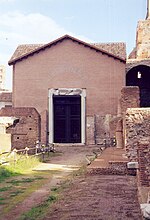
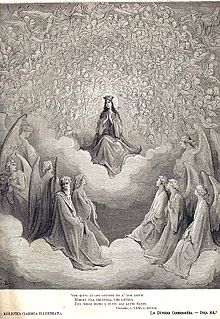
Early Christians focused their piety at first more upon the martyrs; but following that, they saw in Mary a bridge between the old and the new.[41] The earliest recorded prayer to Mary, the Sub tuum praesidium, is dated to around the year 250.[42]
In Egypt the veneration of Mary had started in the 3rd century and the term Theotokos was used by Church Father Origen.[43]
The Renaissance period witnessed a dramatic growth in Marian art.[44] Masterpieces by Botticelli, Leonardo da Vinci and Raphael were produced in this period. In the 16th century, the Council of Trent confirmed the Catholic tradition of paintings and artworks in churches, resulting in a great development of Marian art and Mariology during the Baroque Period.[7] During the Reformation, the Catholic Church defended its Mariology against Protestant views. With the victory at Battle of Lepanto (1571) accredited to her, it "signified the beginning of a strong resurgence of Marian devotions."[45] The baroque literature on Mary experienced unforeseen growth. More than 500 pages of Mariological writings were published during the 17th century alone.[46]
Popes have fostered the veneration of the Blessed Virgin through the promotion of Marian devotions, feast days, prayers, initiatives, the acceptance and support of Marian congregations, and, the formal recognition of Marian apparitions such as in Lourdes and Fátima. Popes Alexander VII and Clement X both promulgated the veneration of the Sacred Heart of Jesus and the Immaculate Heart of Mary, a concept which was embraced by Pope John Paul II in the 20th century as the Alliance of the Hearts of Jesus and Mary.[47][48][49][50]
The two Marian dogmas of Immaculate Conception and Assumption were established by popes in the 19th and 20th century. Pope Pius XII issued the Dogma of the Assumption and the Second Vatican Council declared Mary to be the Mother of the Church.[51] In his 2002 Apostolic Letter Rosarium Virginis Mariae, Pope John Paul II emphasized Louis de Montfort's approach of viewing the study of Mary as a path to gaining a better understanding of the mystery of Christ.[52] This is consistent with the emphasis of the bishops at the Second Vatican Council in not having a separate decree on Mary but rather describing her place in salvation history in Lumen gentium, the Constitution on the Church.[53]
Dogmatic teachings
Marian Catholic dogmas present church teachings about Mary and her relation to Jesus Christ, held by the church to be infallible, and reflect the role of Mary in the economy of salvation.[54][55]
De Fide Definita or De Fide Credenda doctrines have the highest degree of dogmatic certainty. These doctrines come in several forms, namely the sacred scriptures and apostolic tradition[56] and teachings which have been specifically defined as revealed by an extraordinary definition by a pope or ecumenical council (extraordinary universal Magisterium), or those teachings infallibly taught to be revealed by the ordinary universal Magisterium. As in the case of the Immaculate Conception or the Assumption, these doctrines were held by the church prior to the date of official definition, but open for discussion. From the date of definition, they must be accepted by all members of the Catholic Church as contained specifically in the Deposit of Faith and owed supernatural faith in itself (de fide credenda).[54][55]
There are four Marian dogmas specifically defined by the Magisterium among a large number of other dogmas and doctrines about the Virgin Mary – for example, the Annunciation of Mary is dogma because it is in the scriptures, but it has not been formally defined by the Magisterium. These four Marian dogmas include:
| Name | First magisterial definition | Substance of the dogma |
|---|---|---|
| Mother of God | Council of Ephesus (431) | Mother of God, not that the nature of the Word or his divinity received the beginning of its existence from the holy Virgin, but that, since the holy body, animated by a rational soul, which the Word of God united to himself according to the hypostasis, was born from her, the Word is said to be born according to the flesh. |
| Perpetual virginity | Second Council of Constantinople (553) and Lateran Synod (649) | 'Perpetual virginity of Mary', means that Mary was a virgin before, during and after giving birth. |
| Immaculate Conception | Pope Pius IX (1854) | Mary, at her conception, was preserved immaculate from Original Sin. |
| Assumption into heaven | Pope Pius XII (1950) | Mary, having completed the course of her earthly life, was assumed body and soul into heavenly glory. |
Mother of God
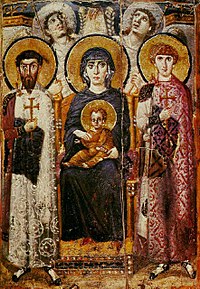
Mary's motherhood of God (Deipara in Latin) is a dogma of the Catholic Church.[57] The term "Mother of God" appears within the oldest known prayer to Mary, the Sub tuum praesidium, which dates to around 250 AD: "Under thy protection we seek refuge, Holy Mother of God". This was the first specifically Marian doctrine to be formally defined by the church, formally affirmed at the Third Ecumenical Council held at Ephesus in 431. This refuted the objection raised by Patriarch Nestorius of Constantinople.[58]
Scriptural basis for the dogma is found in John 1:14 which states "And the Word became flesh, and dwelt among us" and in Galatians 4:4 which states "God sent forth his Son, born of a woman, born under the law".[59] Luke 1:35 further affirms divine maternity by stating: "The holy Spirit will come upon you. ... Therefore the child to be born will be called holy, the Son of God."[60]
The dogmatic constitution Lumen gentium at the Second Vatican Council affirmed Mary as the Mother of God. "The Virgin Mary, who at the message of the angel received the Word of God in her heart and in her body and gave Life to the world, is acknowledged and honored as being truly the Mother of God and Mother of the Redeemer."[61]
This dogma is inherently related to the Christological dogma of the hypostatic union which relates the divine and human natures of Jesus Christ.[57] The Catechism of the Catholic Church teaches that "Mary is truly 'Mother of God' since she is the mother of the eternal Son of God made man, who is God himself."[62] According to Catholic teaching, sourced in the John 1:1-14, Mary did not create the divine person of Jesus, who existed with the Father from all eternity.[58]
Assumption of Mary

This dogma states that Mary was assumed into heaven with body and soul. The Catechism (item 966) states:
The Immaculate Virgin, preserved free from all stain of original sin, when the course of her earthly life was finished, was taken up body and soul into heavenly glory, and exalted by the Lord as Queen over all things.[63]
Pope Pius XII discussed the Assumption in Deiparae Virginis Mariae (1946) and declared it a dogma in Munificentissimus Deus (1950).[64][65][66]
Although the Assumption was only recently defined as dogma, accounts of the bodily assumption of Mary into heaven have circulated since at least the 5th century, and by the 8th century Andrew of Crete and John of Damascus had declared belief in it.[67][68] The Book of Revelation (12:1) has been interpreted as referring to it; with her coronation implying her previous bodily assumption to heaven.[64]
Before declaring the Assumption a dogma in Munificentissimus Deus in 1950, in the encyclical Deiparae Virginis Mariae (1946) Pope Pius XII obtained the opinion of Catholic bishops, and based on their overwhelming support (1210 among the 1232 bishops) proceeded with the dogmatic definition.[64][69] The consensus of Magisterial teaching and liturgy affirms that Mary suffered death before her assumption, but this is not always accepted as settled doctrine. What is most clear is that her body was not left on earth to corrupt.[70][71]
When responding to Pope Pius XII following the circulation of Deiparae Virginis Mariae, a large number of Catholic bishops pointed to the Book of Genesis (3:15) as a scriptural basis.[67] In Munificentissimus Deus (item 39) Pius XII referred to the "struggle against the infernal foe" as in Genesis 3:15 and to "complete victory over the sin and death" as in the Letters of Paul as a scriptural basis for the dogmatic definition, Mary being assumed into heaven also seems to verify 1 Corinthians 15:54: "Then shall come to pass the saying that is written, Death is swallowed up in victory".[67][72][73]
Immaculate Conception of Mary
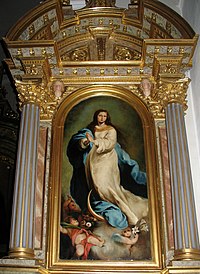
This dogma states that Mary was conceived without original sin. This means that from the first moment of her existence she was preserved by God from the lack of sanctifying grace, and that she was instead filled with divine grace.[74]
The dogma of the Immaculate Conception is distinct from and should not be confused with the perpetual virginity of Mary or the virgin birth of Jesus; for this dogma refers to the conception of Mary by her mother, Saint Anne, and not the conception of Jesus.
The feast of the Immaculate Conception, celebrated on December 8, was established in 1476 by Pope Sixtus IV, but the dogmatic definition came from Pope Pius IX in his constitution Ineffabilis Deus, on December 8, 1854.[74][75][76]
The dogma states that Mary possessed sanctifying grace from the first instant of her existence and by a special and unique gift of God was free from the lack of grace caused by the original sin from the beginning of human history.[77] In Fulgens corona (item 10) Pope Pius XII reaffirmed the concept by stating: "Who will dare to doubt that she, who was purer than the angels and at all times pure, was at any moment, even for the briefest instant, not free from every stain of sin?"[78]
Ineffabilis Deus (as well as Pope Pius XII's Munificentissimus Deus on the Assumption) also teaches the predestination of Mary, in that she was preserved from sin due to the role reserved for her in the economy of salvation.[75] This predetermination of Mary's role in salvation was referred to in Lumen gentium (item 61) which stated that she was "Predestined from eternity by that decree of divine providence which determined the incarnation of the Word to be the Mother of God."[75][28] The definition in Ineffabilis Deus confirms the uniqueness of the Immaculate Conception as a gift from God to Mary, that Jesus might receive his body from one unstained by sin.[74]
Perpetual virginity of Mary

This dogma states that Mary was a virgin before, during and after giving birth (de fide). This oldest Marian doctrine, (also held by Lutheran, Eastern Orthodox, and Oriental Orthodox, and many other Christians) affirms Mary's "real and perpetual virginity even in the act of giving birth to the Son of God made Man."[79] Thus, by the teaching of this dogma, the faithful believe that Mary was ever-Virgin (Greek ἀειπάρθενος) for the whole of her life, making Jesus her only biological son, whose conception and birth are held to be miraculous.[80][81]
The doctrine of perpetual virginity is distinct from the dogma of the Immaculate Conception of Mary, which relates to the conception of the Virgin Mary herself without any stain (macula in Latin) of original sin.[82]
Virginity before birth
This means that Mary conceived by the Holy Spirit without participation of any man (de fide). The Greek term Aeiparthenos (i.e. "Ever Virgin") is attested to from the early 4th century.[83] The Catechism of the Catholic Church (item 499) includes the term Aeiparthenos and referring to the dogmatic constitution Lumen gentium (item 57) states: "Christ's birth did not diminish his mother's virginal integrity but sanctified it."[84][85][86]
Virginity during birth
This means that Mary gave birth without losing her corporal virginity (de fide) and her corporal integrity was not affected by giving birth.[85] The Catholic Church does not teach how this occurred physically, but insists that virginity during child birth is different from virginity of conception.[85]
Virginity after birth
This means that Mary remained a virgin after giving birth (de fide).[85] This belief of the church was questioned in its early years.[87] The scriptures say little about this, mentioning the brothers of Jesus, but never "sons of Mary", suggesting to the patristic writers a broader family relationship.[85][87][88]
Other Marian doctrines
Apart from the four Marian dogmas listed above, the Catholic Church holds a number of other doctrines about the Virgin Mary which have been developed by references to Sacred Scripture, theological reasoning and church tradition.[89]
Queen of Heaven

The doctrine that the Virgin Mary has been crowned Queen of Heaven goes back to certain early patristic writers of the church such as Gregory Nazianzen's "the Mother of the King of the universe", and the "Virgin Mother who brought forth the King of the whole world",[90] Prudentius's the Mother marvels "that she has brought forth God as man, and even as Supreme King."[91] and, Ephrem's, "Let Heaven sustain me in its embrace, because I am honored above it. For heaven was not Thy mother, but Thou hast made it Thy throne. How much more honorable and venerable than the throne of a king is her mother."[92] The Catholic Church often sees Mary as queen in heaven, bearing a crown of twelve stars in Revelation.[93]
Many popes have given tribute to Mary in this regard, for example: Mary is the Queen of Heaven and Earth, (Pius IX), Queen and Ruler of the Universe (Leo XIII) and Queen of the World (Pius XII)[94] The theological and logical foundation of these titles rests in the dogma of Mary as the Mother of God. As mother of God, she participates in his salvation plan. The Catholic faith teaches that Mary, the Virgin Mother of God, reigns with a mother's solicitude over the entire world, just as she is crowned in heavenly blessedness with the glory of a Queen, as Pius XII wrote:[95]
Certainly, in the full and strict meaning of the term, only Jesus Christ, the God-Man, is King; but Mary, too, as Mother of the divine Christ, as His associate in the redemption, in his struggle with His enemies and His final victory over them, has a share, though in a limited and analogous way, in His royal dignity. For from her union with Christ she attains a radiant eminence transcending that of any other creature; from her union with Christ she receives the royal right to dispose of the treasures of the Divine Redeemer's Kingdom; from her union with Christ finally is derived the inexhaustible efficacy of her maternal intercession before the Son and His Father.[95]
Mary as Mother of the Church

The title Mother of the Church (in Latin Mater Ecclesiae) was officially given to the Virgin Mary during the Second Vatican Council by Pope Paul VI.[96] This title goes back to Ambrose of Milan in the 4th century, but this use was not known until its 1944 rediscovery by Hugo Rahner.[96][97] Rahner's Mariology, following Ambrose, saw Mary in her role within the church, his interpretation being based solely on Ambrose and the early Fathers.[97]
The Catechism of the Catholic Church states that the Virgin Mary is mother of the church and of all its members, namely all Christians:[98]
The Virgin Mary ... is acknowledged and honoured as being truly the Mother of God and of the redeemer. ... since she has by her charity joined in bringing about the birth of believers in the Church, who are members of its head. ... Mary, Mother of Christ, Mother of the Church.
Pope Paul VI's Credo of the People of God states:[99][100]
Zdroj:https://en.wikipedia.org?pojem=Roman_Catholic_MariologyThe Mother of the Church, carries on in heaven her maternal role with regard to the members of Christ, cooperating in the birth and development of divine life in the souls of the redeemed.
Text je dostupný za podmienok Creative Commons Attribution/Share-Alike License 3.0 Unported; prípadne za ďalších podmienok. Podrobnejšie informácie nájdete na stránke Podmienky použitia.
Antropológia
Aplikované vedy
Bibliometria
Dejiny vedy
Encyklopédie
Filozofia vedy
Forenzné vedy
Humanitné vedy
Knižničná veda
Kryogenika
Kryptológia
Kulturológia
Literárna veda
Medzidisciplinárne oblasti
Metódy kvantitatívnej analýzy
Metavedy
Metodika
Text je dostupný za podmienok Creative
Commons Attribution/Share-Alike License 3.0 Unported; prípadne za ďalších
podmienok.
Podrobnejšie informácie nájdete na stránke Podmienky
použitia.
www.astronomia.sk | www.biologia.sk | www.botanika.sk | www.dejiny.sk | www.economy.sk | www.elektrotechnika.sk | www.estetika.sk | www.farmakologia.sk | www.filozofia.sk | Fyzika | www.futurologia.sk | www.genetika.sk | www.chemia.sk | www.lingvistika.sk | www.politologia.sk | www.psychologia.sk | www.sexuologia.sk | www.sociologia.sk | www.veda.sk I www.zoologia.sk
